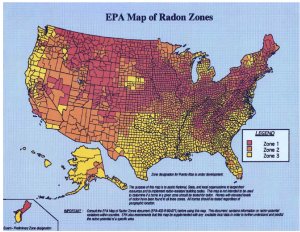Dangers Associated with Radon Gas
November 1, 2013 1:13 pmRadon gas that occurs naturally with the decay of uranium. This gas is colorless, odorless, and tasteless and can be found in ore, shale, limestone and granite. When emitted from these sources it enters the surrounding soil where it can then be disbursed into the air.
So what’s so bad about radon? It’s radioactive and carcinogenic. It is one of the leading causes of lung cancer and if you walked into a room with high levels of radon it would be virtually undetectable. When disbursed through outdoor air, its poses no real threat, but the real danger occurs when this gas gets trapped inside buildings.
How does radon get inside a building? When warm air rises a vacuum is created in the basement or lower level of a building. This vacuum sucks in air from the soil under and around the structure through cracks, windows, and doors.
Are you wondering if granite counter tops can emit radon? The answer is yes.
Radon levels vary throughout the U.S. The map below shows the red (high), orange (moderate) and yellow (lower) levels of radon.
If you have concerns that there may be high levels of radon in your home, office building etc, Radon test kits that meet EPA guidelines can be obtained from a radon testing company or laboratory. The cost is around $25.00 and the testing process is relatively simple.
If the test comes back with high levels of radon there are many methods used to reduce radon levels. Sealing cracks and other openings in the foundation is a basic part of most approaches to radon reduction. Often “sub-slab depressurization” systems are installed which help prevent radon gas enter the building.

